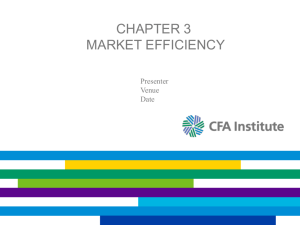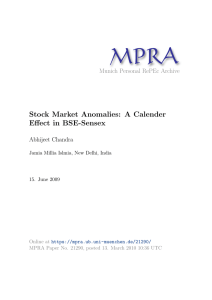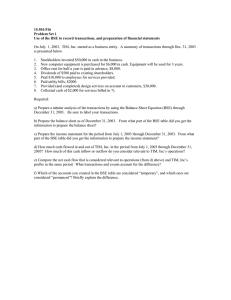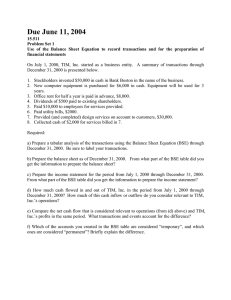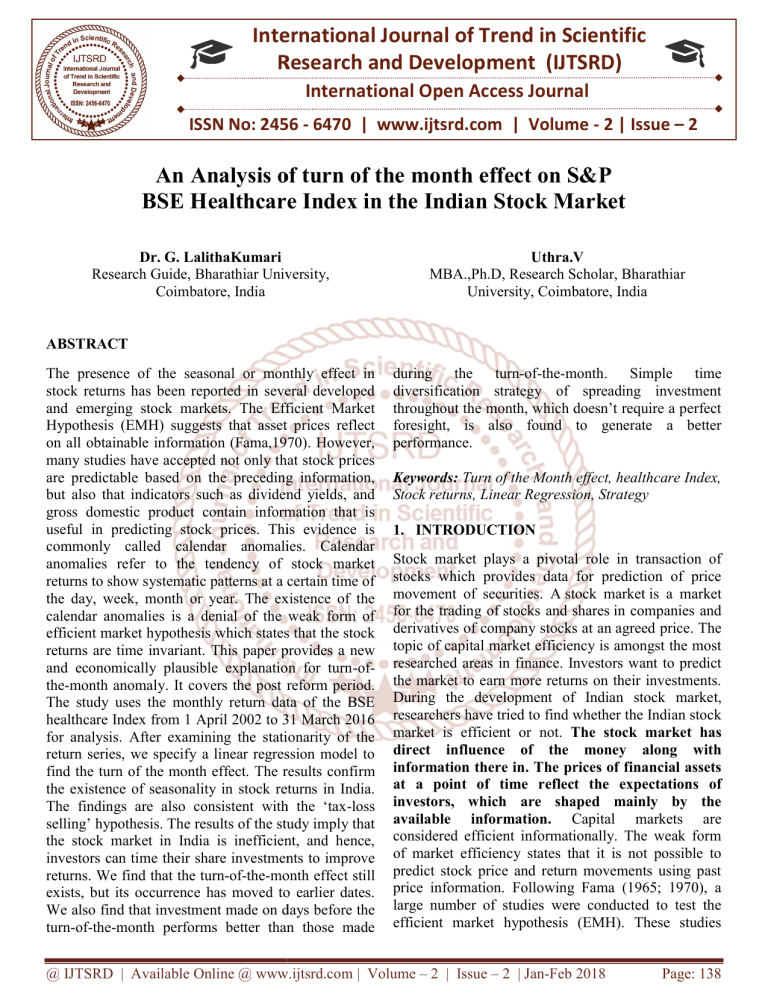
International Journal of Trend in Scientific
Research and Development (IJTSRD)
International Open Access Journal
ISSN No: 2456 - 6470 | www.ijtsrd.com | Volume - 2 | Issue – 2
An Analysis of turn oof the month effect on
n S&P
BSE Healthcare Index in tthe
he Indian Stock Market
Dr. G. LalithaKumari
Research Guide, Bharathiar University,
Coimbatore, India
Uthra.V
MBA.,Ph.D, Research Scholar, Bharathiar
University, Coimbatore, India
ABSTRACT
The presence of the seasonal or monthly effect in
stock returns has been reported in several developed
and emerging stock markets. The Efficient Market
Hypothesis (EMH) suggests that asset prices reflect
on all obtainable information
formation (Fama,1970). However,
many studies have accepted not only that stock prices
are predictable based on the preceding information,
but also that indicators such as dividend yields, and
gross domestic product contain information that is
useful in predicting
dicting stock prices. This evidence is
commonly called calendar anomalies. Calendar
anomalies refer to the tendency of stock market
returns to show systematic patterns at a certain time of
the day, week, month or year. The existence of the
calendar anomalies
es is a denial of the weak form of
efficient market hypothesis which states that the stock
returns are time invariant. This paper provides a new
and economically plausible explanation for turn
turn-ofthe-month anomaly.. It covers the post reform period.
The study
dy uses the monthly return data of the BSE
healthcare Index from 1 April 2002 to 31 March 2016
for analysis. After examining the stationarity of the
return series, we specify a linear regression model to
find the turn of the month effect. The results confi
confirm
the existence of seasonality in stock returns in India.
The findings are also consistent with the ‘tax
‘tax-loss
selling’ hypothesis. The results of the study imply that
the stock market in India is inefficient, and hence,
investors can time their share investments
stments to improve
returns. We find that the turn-of-the-month
month effect still
exists, but its occurrence has moved to earlier dates.
We also find that investment made on days before the
turn-of-the-month
month performs better than those made
during the turn-of-the-month.
month. Simple time
diversification strategy of spreading investment
throughout the month, which doesn’t require a perfect
foresight, is also found to generate a better
performance.
Keywords: Turn of the Month effect, healthcare Index,
Stock returns, Linear Regression, Strategy
1. INTRODUCTION
Stock market plays a pivotal role in transaction of
stocks which provides data for prediction of price
movement of securities. A stock market is a market
for the trading of stocks and shares in companies and
derivatives
tives of company stocks at an agreed price. The
topic of capital market efficiency is amongst the most
researched areas in finance. Investors want to predict
the market to earn more returns on their investments.
During the development of Indian stock market,
marke
researchers have tried to find whether the Indian stock
market is efficient or not. The stock market has
direct influence of the money along with
information there in. The prices of financial assets
at a point of time reflect the expectations of
investors,
rs, which are shaped mainly by the
available information. Capital markets are
considered efficient informationally. The weak form
of market efficiency states that it is not possible to
predict stock price and return movements using past
price information. Following Fama (1965; 1970), a
large number of studies were conducted to test the
efficient market hypothesis (EMH). These studies
@ IJTSRD | Available Online @ www.ijtsrd.com | Volume – 2 | Issue – 2 | Jan-Feb 2018
Page: 138
International Journal of Trend in Scientific Research and Development (IJTSRD) ISSN: 2456-6470
generally have shown that stock prices behave
randomly. More recently, however, researchers have
collected evidence contrary to the EMH. They have
identified systematic variations in the stock prices and
returns. The significant anomalies include the small
firm effect and the seasonal effect. The existence of
the seasonal effect negates the weak form of the EMH
and implies market inefficiency. In an inefficient
market investor would be able to earn abnormal
returns, that is, returns that are not commensurate with
risk.
Financial market anomalies are cross-sectional and
time series patterns in security returns that are not
predicted by a central paradigm or theory. A great
deal of research has been devoted to the investigation
of the randomness of stock price movements in order
to judge the informational efficiency of stock markets.
There are a large number of anomalies documented by
researchers and still continues to grow. In which some
important or famous market anomalies are calendar
anomalies and fundamental anomalies. Anomalies
that are linked to a particular time are called calendar
effects. This time may be an hour of the day, or a day
of the week or a week of the month or a month of the
year etc. Calendar effects in stock markets have
always been a challenge for finance economists; as
these are difficult to explain with in standard
framework of financial economics. Predictable
patterns in stock prices are inconsistent with the
efficient market hypothesis. Therefore, researchers
have shown great interest in the study of Calendar
anomalies – finding them and trying to understand
them in light of the market frictions and behavioural
imperfections. The different patterns identified in
stock returns include the January Effect, Day of The
Week Effect, different monthly effect like Turn of the
Month Effect, Semi Month Effect, the End of the
Month Effect, etc.
The trend of stock prices to increase during the last
two days and the first three days of each month is
called the Turn of the Month Effect. For this study,
the average returns on the last two trading days of the
preceding month, and the first three days of the
subsequent month were computed and compared with
the mean return for the rest of the days in the
subsequent month. India has played a key role in
Information Technology (IT) industry in the
worldwide, accounting for approximately 67 per cent
of the US$ 124-130 billion market. IT industry has
been one of the key development providers to the
Indian economy. The IT industry employs more than
10 million Indians to contribute deliberately to bring
out social and economic change in the country. The IT
industry has played a key role in renovating India’s
image from a slow moving bureaucratic economy to a
land of innovative entrepreneurs and a worldwide
player in providing world class technology solutions
for commercial services. The industry has helped
India to transmute to knowledge based economy from
a rural and agriculture-based economy. Information
Technology has made probable evidence access at
gigabit speeds. It has made remarkable impact on the
lives of millions of people who are poor, living in
rural and far flung landscapes. The Internet has made
radical changes with the potentials of e-government
measures like e-health, education, e-agriculture, etc.
The IT-BPO sector in India grew at a compound
annual growth rate (CAGR) of 25 per cent over 20002013, which is 3-4 times higher than the worldwide
IT-BPO spend, and is probable to expand at a CAGR
of 9.5 per cent to US$ 300 billion by 2020. The BSE
Healthcare index provides investors and market
intermediaries with an appropriate benchmark that
captures the performance of the Indian IT companies.
1.1 Turn of The Month Effect
The turn-of-the-month effect refers to the unusually
high stock returns at the turn of the month defined as
the period from the last trading day of the previous
month to the first three trading days of the current
month. It refers to the stock return that is abnormally
high for some specific trading days within a month. It
has been observed that a positive rate of return occurs
only in the first half of the month beginning from the
last few days of the previous month. This implies that
average daily returns of stocks on turn of the month
are different from the average daily returns in rest of
the month.
2. REVIEW OF LITERATURE
1. P. Nageswari, Dr. M. Selvam and Dr. J.
Gayathri (2011)1 in their research entitled “An
empirical analysis of Semi-Month and Turn of the
Month effects in Indian stock market” investigated
the Semi-month and Turn of the month effects in an
1
P. Nageswari, Dr. M. Selvam and Dr. J. Gayathri (2011),“An
empirical analysis of Semi-Month and Turn Of the Month effects
in Indian stock market”,International Journal of Research in
Commerce, Economics & Management,Vol.1,Issue.3,pp.104112.
@ IJTSRD | Available Online @ www.ijtsrd.com | Volume – 2 | Issue – 2 | Jan-Feb 2018
Page: 139
International Journal of Trend in Scientific Research and Development (IJTSRD) ISSN: 2456-6470
emerging Indian Capital Market. The S&P CNX Nifty
and BSE Sensex Index data have been collected and
analysed for a period of six years from 1January 2005
to 31December 2010. OLS Regression Model was
used for analysis to examine the semi-month and Turn
of the month effect. The analysis of the selected
indices (BSE Sensex and S&P CNX Nifty) showed
that highest mean returns was recorded for the first
half month than the rest of the days of the month. The
study revealed that the semi-month effect does not
exist in BSE Sensex and S&P CNX Nifty index
returns during the study period. The study found that
there was inverse relationship between risk and return
of the series i.e. high (low) return was associated with
lower (high) risk. The existence of these anomalies
may provide opportunities to formulate profitable
trading strategies so as to earn the abnormal return.
2. Huson Joher Ali Ahmed and ZiaulHaque(2007)2
in their paper entitled “The day of the week, turn
of the month and January effect on stock market
volatility and volume: Evidence from Bursa
Malaysia “focused on three important calendar events
namely day of the week, turn of the month and
January effect. Using both a GARCH (1 1)-M model
and a mixture of distribution hypothesis (MDH) this
paper investigated the return and conditional volatility
pattern of the Malaysian stock index over the period
from 1994 to 2004. In an attempt to isolate the effect
of the 1997 crisis, the sample period was divided into
three sub periods namely “pre-crisis”, “during crisis”
and “post crisis”. Findings indicated the presence of a
weekend effect suggesting Monday returns to be
significantly negative across the three sub periods and
provide strong explanation for both return volatility
patterns on Malaysian capital market. No clear pattern
of January or turn of the month effect was observed in
the study. However, when the sample period is
subdivided based on economic conditions, the turn of
the month effect is found to be positive and
significant for the pre crisis period and negative for
post crisis period. The January effect appeared to be
present in the post crisis period only. The findings
implied that the behavioral pattern of Malaysian
traders has been changed since the 1997 Asian crisis
period.
3. William S. Compton, Don T. Johnson and
Robert A. Kunkel (2006)3 in their research paper
entitled “The turn-of-the-month effect in real estate
investment trusts (REITs)” examined the market
returns of five domestic real estate investment trust
(REIT) indices to determine whether they exhibit a
turn-of-the-month (TOM) effect. Daily returns are
obtained from January 1999 to December 2003 for all
indices except the real estate 50 REIT, which has
daily returns starting in January 2000.A series of
parametric and non-parametric statistical tools were
used to determine the existence of turn of the month
effect.An OLS regression model compares the TOM
returns with the rest-of-the- month (ROM) returns and
an ANOVA model examines the TOM period while
controlling for monthly seasonality. A non-parametric
t-test examines whether the TOM returns are greater
than the ROM returns and a Wilcoxon signed rank
test examines the matched-pairs of TOM and ROM
returns.The findings revealed that TOM effect in all
five domestic REIT indices were found: real estate 50
REIT, all-REIT, equity REIT, hybrid REIT, and
mortgage REIT.
4. McGuinness (2006)4 in his study entitled “Turn of
the month anomalies-a global research on small,
mid and large cap indices” attempted to examine the
existence of TOM effect in order to gain more
generalized and global knowledge of the behavior of
the TOM effect anomaly. Of the selected 20 countries
the study has tried to extract three index types: Large
cap, mid cap and small cap, from 1January 1988 until
29December 2006. Both parametric and non
parametric test has been employed in this study.The
study conducted 2 parametric tests, and a nonparametric test, on each of the three chosen indices
from each country. The parametric test used for the
study is a simple linear regression and a one-way
ANOVA test and the non-parametric test is a
Wilcoxon signed rank (WSR) test. The conclusion of
these 3 tests found TOM effect exists in each index in
each country.
3
2
HusonJoher Ali Ahmed and ZiaulHaque(2007), “The day of the
week, turn of the month and January effect on stock market
volatility and volume: Evidence from Bursa Malaysia”, SSRN
Working Paper Series(Electronic copy available at:
http://ssrn.com/abstract=1460374).
William S. Compton, Don T. Johnson and Robert A. Kunkel
(2006),“The turn-of-the-month effect in real estate investment
trusts (REITs)”, Managerial Finance,Vol.32,Iss.12,pp.969 – 980.
4
McGuinness (2006),“Turn of the month anomalies-a global
research on small, mid and large cap indices”, Financial Analysts
Journal,Vol.62,Issue.5,pp.78-89.
@ IJTSRD | Available Online @ www.ijtsrd.com | Volume – 2 | Issue – 2 | Jan-Feb 2018
Page: 140
International Journal of Trend in Scientific Research and Development (IJTSRD) ISSN: 2456-6470
5. EleftheriosGiovanis (2006)5 in his study entitled
“The turn-of-the-month-effect: Evidence from
Periodic Generalized Autoregressive Conditional
Heteroskedasticity (PGARCH) Model” investigated
the turn of the month effect in stock market indices
around the globe (20 countries) for the period of 1990
to 2013 and to test its pattern, which can be used for
the optimum asset allocation with result the
maximization of profits. Ordinary Least Squares
(OLS) is problematic as it leads to unreliable
estimations because of the autocorrelation and
Autoregressive
Conditional
Heteroskedasticity
(ARCH) effect existence. Due to this reason
Generalized GARCH models was estimated. Two
approaches are followed in this study. The first is the
symmetric Generalized ARCH (1,1) model. However,
previous studies found that volatility tends to increase
more when the stock market index decreases than
when the stock market index increases by the same
amount. In addition there is higher seasonality in
volatility rather on average returns. For this reason the
Periodic-GARCH (1,1) is estimated. The findings
revealed positive returns at the beginning of the
month and zero returns in the latter part of the month.
Thus, investors can improve their returns by timing
their investment.
3. STATEMENT OF THE PROBLEM
The trading of securities had gained more popularity
with increase in investment patterns and volume of
trade. No market expert can predict exactly the
timings for buying and selling of shares, though the
technical software can provide support and resistance
levels in the chart for the current term. The corporate,
firms and Government generally release good and bad
news between First half month and last half Month
respectively. As a result, the bad news is reflected in
lower the stock prices and good news is reflected in
higher stock prices. When new positive information
reaches the market, the prices become bullish due to
buying pressure. The active trading strategies, based
on the knowledge of market anomalies, would provide
benefits to the investors; but the countervailing
arbitrage will also exploit the excess return over time.
In the process, observed anomalies will eventually
5
EleftheriosGiovanis (2006),“The turn-of-the-month-effect:
Evidence from Periodic Generalized Autoregressive Conditional
Heteroskedasticity (PGARCH) Model”, SSRN Working Paper
Series
(Electronic
copy
available
at:
http://ssrn.com/abstract=2479295 ).
disappear and pave the way to make the market more
efficient. The study attempts to understand the
existence of market anomalies in the Indian Stock
market. Therefore, we need to examine whether turn
of the month anomaly persist for a long period and if
investors based on this seasonality are able to make
profits. The present study will be useful to the
investors, traders and arbitrageurs who could
formulate profitable trading strategies if they were
able to predict the share price behaviour with full
information on these anomalies.
4. THE PURPOSE OF THE STUDY
The effect of Calendar Anomalies may scramble or
depress the share price on a particular day/week or
month as compared to the mean. Traditional asset
pricing models cannot explain the changes in the price
and the changes also violate the Weak Form of
Market Efficiency (i.e. asset prices fully reflect all
past information). Recent liberalization policies have
led to significant capital flows into India seeking to
capitalize on promising and profitable business
opportunities. As a result, International Investors are
concerned with the market efficiency, timing of
investment, and the market integration with other
developed countries .We need to examine whether
there is calendar anomalies in stock returns persist for
a long period and if investors based on this
seasonality are able to make profits. According to
efficient market hypothesis, it is not allowable for
someone to use strategies based on seasonality in
order to have profits. EMH also states that no
investing group has the ability to have excessive
returns for a long period. The present study would be
useful to the investors, traders and arbitrageurs who
could formulate profitable trading strategies if they
were able to predict the share price behavior with full
information on these anomalies. The share price
behavior in one market spreads slowly to the other
developing and developed markets. As research on
seasonality is still at a nascent stage, the current study
could possibly help in understanding and explaining
such seasonality in the Indian capital markets. The
presence of Calendar Anomalies in stock markets
across the country is widely reported and these
anomalies should be investigated in India. The
detailed investigation of the Calendar Anomalies in
the Indian Markets would help the international and
Indian investors to plan their investment. The
periodical study of this nature is of use to all types of
users, including market participants. The purpose of
the research is to review, integrate and extend the
@ IJTSRD | Available Online @ www.ijtsrd.com | Volume – 2 | Issue – 2 | Jan-Feb 2018
Page: 141
International Journal of Trend in Scientific Research and Development (IJTSRD) ISSN: 2456-6470
studies of stock market anomalies and to understand
the trading strategic formulation on the basis of
Calendar anomalies for the utmost benefit of the
investors.
•
5. OBJECTIVES OF THE STUDY
To test the existence of turn of the month effect in
the BSE index
To test the efficiency of the stock market.
To develop trading strategy for investors based on
the calendar effects.
•
•
5.1 Hypothesis of the Study
The following Hypotheses was developed and tested.
•
(i) The Economic Times, India
(ii) Financial Express, India.
Journals / Magazines:
(i) Business India
(ii) Capital Market
(iii) Dalal Street
(iv) Economic and Political Weekly
(v) Fortune (Asia Edition)
CAPITALINE DATABASE (the online database
maintained by the Capital Market Publishers India
Private Limited);
CAPITACHART DATABASE (the online
database maintained by the Capital Market
Publishers India Private Limited);
PROWESS DATABASE (the online database
maintained by the Center for Monitoring of Indian
Economy- CMIE);
Websites:(i) Website of Bombay Stock Exchange
: www.bseindia.com
H01: There is no significant difference in the mean
monthly returns of turn-of-the month and rest-of-the
month
•
6. METHODOLOGY OF THE STUDY
6.3 Sample of the study
The tendency of stock prices to increase during the
last two days and the first three days of each month, is
called Turn of the Month Effect. For the purpose of
this study, the average of the return on the last two
trading days of the preceding month, and the first
three days of the subsequent month were computed
and compared with the mean return for the rest of the
days in the subsequent month (Bodla BS, Kiran Jindal
2006).
To study the seasonal behaviour of stock prices, the
sample selected is S&P BSE Healthcare index. The
data constitutes daily data and the sample period of
the study spans from 2002 to 2016.The literature
shows that researchers have used only closing prices.
Rather average of these four prices can yield better
results as it can control volatility up to some
extent. Hence, in this study daily close, open, high
and low prices were considered.
6.1 Period of the Study
6.4 Software Packages
The Compulsory Rolling Settlement System was
introduced by SEBI on January 02, 2002 in the stock
exchange. It reduces the market risk of stocks to a
considerable extent. The investors get their money /
securities much faster, thus enhancing their liquidity.
The introduction of Rolling Settlement leads to high
turnover and creates impact on the Anomalies
Behaviour of stock. Thus, an attempt has been made
in this study, to identify the turn of the month
Anomaly in the Indian Stock Market during the Post
Rolling Settlement Period from April 2002 to March
2016. Hence the period of present study covers a
period of 14 years from 1April 2002 to 31March
2016 (i.e. Post Rolling Settlement Period).
We have used SPSS 15.1 for the primary analysis of
the data. EVIEWS 9 has been used for the
econometric modelling.
6.2 Sources of Data Collection
The main sources of data are given below:
•
Financial Dailies:
6.5 Tools Used for Analysis
(i)
The daily close, open, high and low prices of
the respective stocks have been taken and
average price is calculated and then logarithm
return of these prices has been calculated.
(ii)
After finding the return, the next step is to
check for the normality of the return using the
summary statistics like Arithmetic Mean,
Standard Deviation, Skewness, Kurtosis and
Jarque- Bera test. If the Mean and Median are
approximately equal, Skewness is zero,
Kurtosis is around three and if the Jarque-Bera
value is significant, then it is interpreted that
the series follow normal distribution.
@ IJTSRD | Available Online @ www.ijtsrd.com | Volume – 2 | Issue – 2 | Jan-Feb 2018
Page: 142
International Journal of Trend in Scientific Research and Development (IJTSRD) ISSN: 2456-6470
(iii)
Linear Regression Model is a standard
methodology that is initially employed to test
theTurn-of-the Month Effect.
Table 1.1 The Results of Descriptive Statistics for
S&P BSE Healthcare indexDaily Returns - Turn of
the Month wise from April 2002 to March 2016
7. ANALYSIS
Statistics
First Half
Second Half
7.1 Analysis of Descriptive Statistics for S&P BSE
Healthcare index
Mean Return
0.2846
0.0888
Standard Deviation
2.7860
1.4921
As shown in Table 1.1the results of Descriptive
Statistics of the Turn of Month returns in S&P BSE
Health Care index returns from April 2002 to March
2016. The above table describes that the mean return
of the First Half Month was higher (0.284) than that
of the Second Half month (0.088) returns. Hence it is
suggested that investors may buy the shares during the
Second Half Month Period, which is low because it
will give better returns to the investors. And sell their
holdings in the First Half month.
Sample Variance
7.7619
2.2265
Kurtosis
19.3898
9.2756
Skewness
-1.9689
0.3924
Range
39.3437
22.1775
Minimum
-25.9168
-9.4277
Maximum
13.4269
12.7498
Sum
239.1039
235.1337
Count
840
2647
The risk of the First Half month returns higher than
the Second Half month. The peak of the return
distribution was Leptokurtic in both First and Second
Half month returns. Highest value of 19.38 recorded
in First Half month returns. The return distribution
was Negatively Skewed, which is -1.96inFirst Half
month and positively skewed, which is 0.39 in Second
Half Month returns.
Source: Computed using Ms.-Excel
Chart 1.1 demonstrated the average Returns of First
Half and Half Month Returns for S&P BSE Health
Care Index from April 2002 to March 2016. It is
perceived that the highest mean return was recorded
in the First Half Month and lowest mean return was
recorded in the Second Half Month.
Chart 1.1 Average Daily Returns – ‘Turn of the Month Wise’ for S&P BSE Healthcare index returns
from April 2002 to March 2016
Mean Return
0.2500
0.2000
0.1500
First Half
0.1000
Second Half
0.0500
0.0000
First Half
Second Half
Source: Computed from Table 1.1
@ IJTSRD | Available Online @ www.ijtsrd.com | Volume – 2 | Issue – 2 | Jan-Feb 2018
Page: 143
International Journal of Trend in Scientific Research and Development (IJTSRD) ISSN: 2456-6470
7.2 Analysis of Linear Regression Model for BSE
S&P Healthcare index
The Results of Linear Regression analysis of S&P
BSE Health Care Index Returns for the period from
April 2002 to March 2016 was given in Table 1.2. It
is understood that the analysis of the study indicates
that the coefficient of daily return in First Half month
was positive (0.3050) and Second Half of the
Calendar Month (-0.3021) was negative. But both
were significant from zero at the 1% level. The Fstatistic value was very high (41.3) and significant at
1% level. It indicates that the overall fit of the model
was good. It concluded that, the Turn of the Month
Effect did exist in S&P BSE Health Care Index
Returns during the study period.
Table 1.2: The Results of Linear Regression Model for S&P BSE Health Care Index Returns - Turn of
the Month wise from April 2002 to March 2016
Variable
Coefficient
Std. Error
t-Statistic
Prob.
SECOND
-0.3021
0.0470
-6.4268
0.0000**
C
0.3050
0.0410
7.4484
0.0000**
R-squared
0.0117
Akaike info criterion
3.1813
Adjusted R-squared
0.0114
Schwarz criterion
3.1848
F-statistic
41.3033
Hannan-Quinn criter.
3.1825
Prob(F-statistic)
0.0000
Durbin-Watson stat
1.8037
Source: Computed using E-views
**Significant at 1% level.
8. FINDINGS AND SUGGESTIONS
From the findings, for the BSE Healthcare sectoral
index the First Half Month returns was higher than
that of the Second Half month returns.
Hence it is suggested that investors may buy the
shares during the Second Half Month Period,
which is low because it will give better returns to
the investors.
And sell their holdings in the First Half month.
The risk of the turn of the month return
distribution was highly volatile in First Half
Month and least volatile in rest of the days of the
month for all the sample sectoral indices during
the study period.
It also observed that there was direct relationship
between risk and return. That is high risk with
high return and vice-versa.
Hence, it suggested that that the policy makers
may try to reduce the inverse risk return
relationship.
The Results of Linear Regression analysis found
that there was significant difference between the
returns of First half month and Second Half month
returns.
The analysis of the study further indicated that the
coefficient of daily return in First Half month was
positive and Second Half of the Calendar Month
was negative.
But both were significant from zero at the 1%
level. The F-statistic value also high and
significant at 1% level. It indicates that the overall
fit of the model was good.
So it confirm the Turn of the Month Effect exist
in BSE Healthcare index returns during the study
period.
BOOK REFERENCES
1. Avdhani, V.A.,” Security Analysis and Portfolio
Management”, (10thed; Mumbai: Himalaya
Publishing House, 2007)
2. PunithavathyPandian,”Security Analysis and
Portfolio Management”,( 10thed ;Mumbai: Vikas
Publishing House,2007)
3. S.Kevin,”Security
Analysis
and
Portfolio
Management”,( 10thed; New Delhi:Prentice Hall,
2008)
4. V.K.Bhalla,”Investment Management–Securities
Analysis
and
Portfolio
@ IJTSRD | Available Online @ www.ijtsrd.com | Volume – 2 | Issue – 2 | Jan-Feb 2018
Page: 144
International Journal of Trend in Scientific Research and Development (IJTSRD) ISSN: 2456-6470
Management”,( 10thed; New Delhi: Prentice Hall,
2006)
WEBSITE REFERENCES
1.
www.money.rediff.com/companies/marketcapitalisation/groupa
2.
www.asiancorrespondent.com/656/top-10indian-companies-by-market-capitalization/
3.
www.moneycontrol.com/stocks/marketinfo/ma
rketcap.php?optex=BSE
4.
www.marketriser.com/2011/04/best-sectors-toinvest-in-india-best.html
5.
www.moneycontrol.com/stocks/topcompanies-in-india/earning-per-share-bse.html
6.
www.indianstocksinfo.com/smallcap.html
7.
www.stockmarketindian.com/stock_tips/price_
to_earning_EPS_stocks.html
8.
www.x-rates.com/d/INR/table.html
9.
www.kotaksecurities.com/university/Equity4.h
tml
10.
www.bseindia.com/stockinfo/indices.aspx
11.
www.bankrate.com/rates/interest-rates/91-daytreasury-bill.aspx
@ IJTSRD | Available Online @ www.ijtsrd.com | Volume – 2 | Issue – 2 | Jan-Feb 2018
Page: 145

